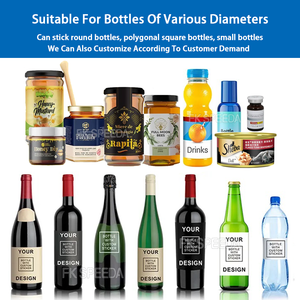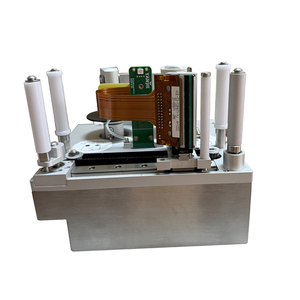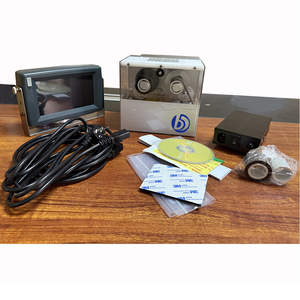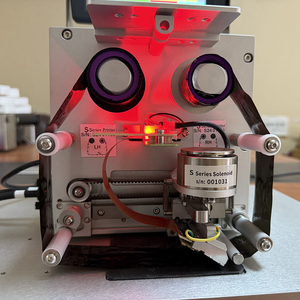
All categories
Featured selections
Trade Assurance
Buyer Central
Help Center
Get the app
Become a supplier

(1670 products available)


























An IML labeling machine creates in-mold labels that both serve as branding for the product being packaged and function as part of the packaging itself. These labels are typically made from polypro and other plastic compounds, which are then attached to the container during the molding process.
Separating the label application process from the mold creation saves manufacturers both time and money, while also improving labeling efficiency and producing a better-end product. The types of IML-labeling machines can be split up into the kind of product they are meant for and the kind of technology they use.
The above are some of the IML-labeling machines based on their methods of labeling. Others are categorized by product shape and size.
Container compatibility
IML labelling machines can work with many container forms and materials. They are good at labelling containers made of plastic (e.g., PP, PS, PETG, PVC), paper, or composite materials. Therefore, they are widely used in the packaging industry.
Labelling speed
Labelling speed is a key feature of an IML labelling machine. Different models offer various labelling speeds. Usually, the high-speed model's labelling speed is more than 200 pieces per minute. This helps with mass production and improves efficiency.
Labelling precision
Labelling precision is another important feature of IML labelling machines. Depending on the model, the precision can be within ±2mm, ±1mm, or even better. High labelling precision can ensure that labels are accurately placed on the packaging, improving the quality and appearance of the products.
Automaticness
The IML labelling machine may have various automaticness levels, including fully automatic, semi-automatic, etc. The fully automatic machine can carry out automatic feeding, labelling, and delivery processes, which helps to reduce manual intervention and improve production efficiency.
For keeping the working performance, working efficiency, and service life of the in-mold labeling machines, regular maintenance is quite important. The following are some routine maintenance tips:
Daily check and cleaning
Users should inspect the machine daily. They should check whether there are any loose or damaged parts, making sure the label and marking material supply systems work properly, and ensuring the machine's driving and electric systems are error-free. Users need to clean the residue and dirt on the label and marking material feeding paths, guiding tracks, and printing heads to avoid blockage and quality issues.
Periodic parts replacement
Users should periodically replace the wearing parts (e.g., the feeding belts, guiding tracks, and the printing head's nozzles). The replacement is essential for ensuring the stability, smoothness, and accuracy of the labelling.
Lubrication
Perform regular lubrication on the moving parts and transmission system of the in-mold labelling machine. Apply the proper lubricant as per the machine's manual to ensure smooth operation and reduce wear.
Electric system maintenance
Check the wires and connections of the electric drive system and control system periodically to ensure they are in good condition and properly secured, thus avoiding electric leakage or circuit faults.
Regular calibration
Users need to calibrate the position, precision, and alignment of the label and marking material printing units. Regular calibration is necessary for ensuring the machine's precision and labelling quality.
Due to their numerous advantages and uses, IML labeling machines have found a broad spectrum of applications in several industries, specifically for container labeling.
Food packaging is expected to remain the most dynamic application area. The rapid growth of ready-to-eat meals, frozen meals, sauces, and snacks market segments in the U.S. and several European countries will spur demand for IML labelers for containers. Innovations like the shift toward clean-label packaging and the need for longer shelf-life solutions drive the adoption of in-mold labeling machines in the food sector.
The global demand for IML labelers for containers used in the food and beverage sector is projected to rise steadily through the end of this decade, fueled by growing brand recognition among customers and the demand for hotel-quality, ready-to-eat meals and beverages. The need to be environmentally friendly will further boost demand for in-mold labelers for containers to replace glue and self-adhesive labeling systems for other nonimmersion labeling systems.
IML labeling machines provide accuracy, traceability, and efficiency in industries requiring high-quality labeling standards. This trend can be observed in chemical and pharmaceutical sectors that must comply with strict standards and regulations. In these sectors, IML labeling machines create error-free labels with billable quantities, specifications, and other important elements. These machines also provide a transparent and accountable supply chain by assisting in the tracking and tracing of products.
Labeling machines with IML technology cater to a wide range of distinct segments within the cosmetics and personal care industry. The shift toward premium packaging that is also seamless and aesthetically pleasing is anticipated to bolster the demand for IML labelers for containers within these segments. Developments in design and printing technologies are introducing new possibilities for customized, branded, and private-label containers, further propelling the market for IML labelers in the cosmetics and personal care sector.
The e-commerce industry continues to rise as more consumers prefer to shop online. Packaging solutions that withstand long-distance transportation and retain product integrity upon arrival at the end user are in high demand. IML labeling machines provide durable, crystal-clear labels that ensure traceability and brand visibility, reducing the risk of mislabeling and product returns.
Thus, IML labeling machines have become increasingly necessary as a result of the emergence of various application areas and distinct use cases across numerous industries. IML labeling machines increase productivity, accuracy, and efficiency in the manufacturing and packaging sectors because of their unparalleled labeling precision, quickness, and adaptability.
When buying an IML labeling machine for sale, buyers should consider the following:
Labeling speed
ML labeling machines can be fast or slow, depending on the specific model, construction, and design. The speed of the IML labeling machine can affect the productivity of the packaging process. Buyers should get a model whose labeling speed matches the demand of their production line.
Automation
An automated IML labeling machine can perform several tasks without human input. It can also have a preset that helps it carry out repetitive tasks precisely and quickly. When choosing an IML labeling machine, buyers should consider the level of automation required and get a machine that matches the desired efficiency and minimal labor requirements.
Labeling accuracy
The accuracy of the label provided by the IML machine is very important. Accurate, high-precision labeling reduces error rates and improves product quality. When choosing the IML machine, buyers should get a model that provides high-precision labeling.
Flexibility and scalability
When choosing the IML labeling machine, buyers should get a model that can adjust the labeling parameters to accommodate changes in production volume and schedule. The machine should also have a design that allows for easy addition to existing set-ups.
Production cost
Consider the cost of operating and maintaining the machine in relation to the labeling speed and accuracy. Buyers should evaluate the IML labeling machine's amortization cost, including its maintenance, label requirement, and energy consumption.
Quality of the machine
Apart from the IML labeling machine's price, buyers should consider the quality of the machine. Get a machine with high build quality, robust construction, and reliable performance. Go for the one that can withstand constant use in harsh production environments.
Q1: What materials does an IML labeling machine use for its labels?
A1: IML labeling machines typically use polypropylene (PP) labels due to its lightweight, clarity, design flexibility, and excellent adhesion. In some cases, other materials like polyethene (PE) for its durability, polystyrene (PS) for its cost-effectiveness, or PVC for its excellent optical clarity can be used.
Q2: Can an IML labeling machine work with non-IML materials?
A2: No. IML labeling machines are specifically designed to work with IML materials. Using non-IML materials can affect the labeling quality, efficiency, and automated system.
Q3: Can an IML labeling machine be automated?
A3: Yes. The IML labeling machine is already an automated system. IMML labeling machines increase production speed by incorporating automation components such as robotics, conveyors, and sensors.
Q4: Can an IML labeling machine still work in humid environments?
A4: Yes. IML labeling machines are suitable for humid environments due to their fine-quality metal and anti-rust coating. However, care should be taken to maintain the proper humidity and temperature levels within the surroundings to ensure optimal machine performance and prevent any label adhesion issues.